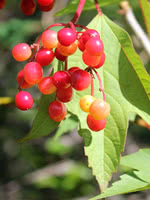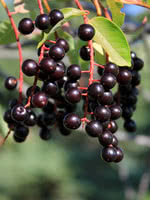Mon-Fri 9am - 5pm Mountain time
Highbush Cranberry vs Western Chokecherry
Viburnum opulus var. americanum (trilobum)
Prunus virginiana var. demissa
Highbush Cranberry produces attractive white flowers in late June and bears edible fruit that matures to a bright red colour in the late summer.
This shrub, native to much of Canada, is fast growing, and its fruit can be eaten raw or cooked into a sauce.
Western Chokecherry is a shrub or small tree commonly used for farmstead and field windbreaks.
It produces white flowers in the spring and edible dark purple fruit that matures between September and October. Its cherries are great for making for making jams, jellies or wine, but are not very palatable for raw eating.
Highbush Cranberry Quick Facts
Western Chokecherry Quick Facts
Toxicity: toxic to horses, cattle, etc.)
In row spacing: 0.6 m (2.0 ft)

